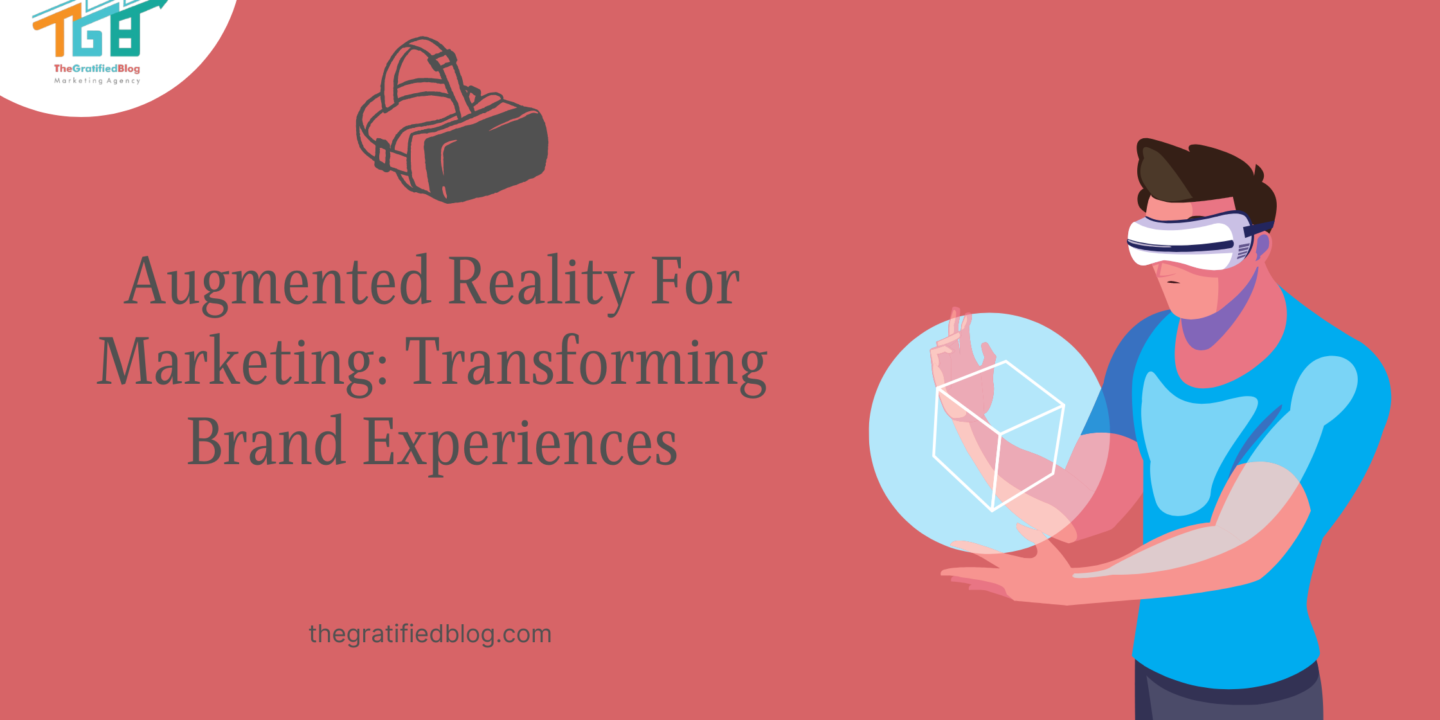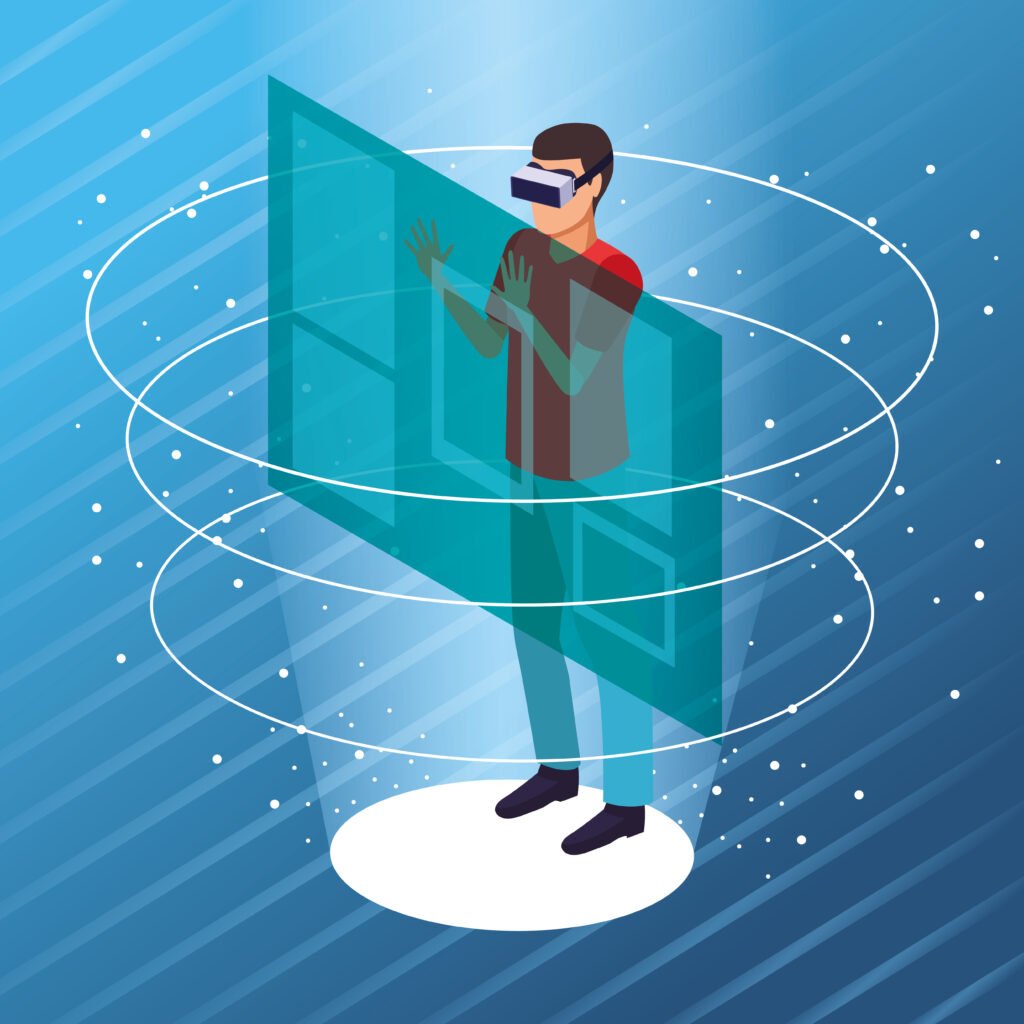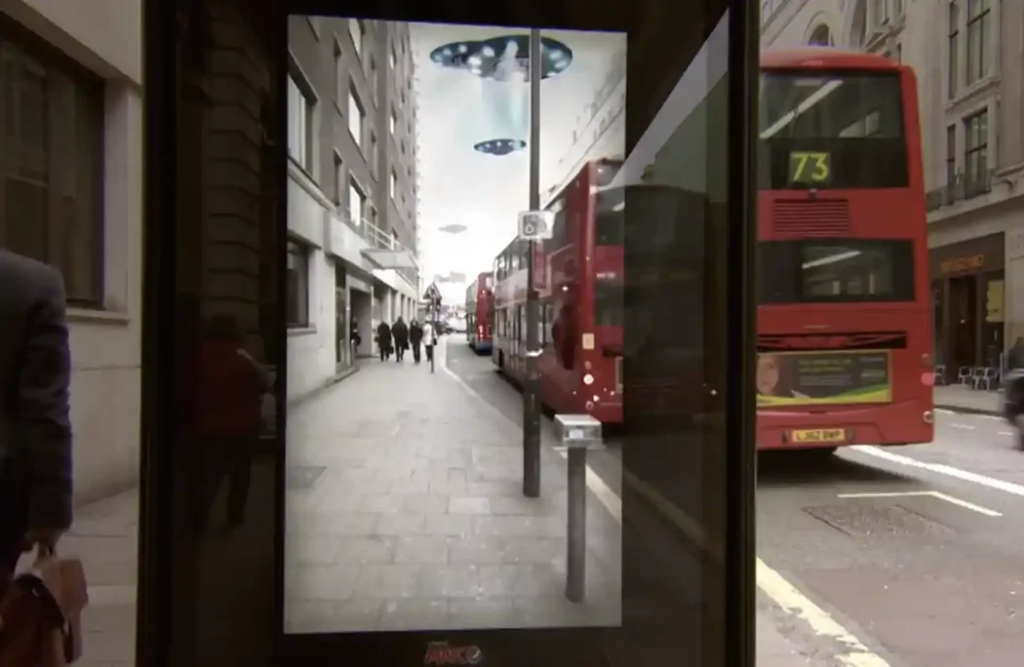
Today’s ever-evolving marketing landscape requires embracing cutting-edge technologies that captivate audiences and drive engagement. One such groundbreaking technology that has revolutionized the marketing sphere is augmented reality (AR). Augmented reality for marketing has emerged as a powerful tool, seamlessly blending digital content with the natural world to create immersive and interactive consumer experiences.
This blog post explores augmented reality in marketing, covering its benefits, implementation strategies, future trends, examples, and concluding insights.
Before discussing augmented reality’s exciting potential in shaping future marketing strategies, let’s first define it.
What is augmented reality?

Augmented reality (AR) is a technology that projects digital content like images, videos, or 3D models into the real world. Unlike virtual reality (VR), which immerses users in a completely virtual environment, AR enhances the real-world environment by adding virtual elements.
This is commonly accomplished using devices such as smartphones, tablets, or AR glasses, employing cameras and sensors to recognise the user’s environment and overlay digital content accordingly.
What Is Augmented Reality For Marketing?
Augmented reality for marketing leverages ar technology to create engaging and interactive consumer experiences. It allows brands to superimpose digital content, such as product demonstrations, interactive ads, or virtual try-on experiences, onto the physical world.
By smoothly merging the virtual and physical domains, AR marketing enhances customer engagement, drives brand awareness, and facilitates more immersive interactions with products or services.
Benefits Of Augmented Reality In Marketing
- Enhanced Customer Engagement: Augmented reality in marketing enhances customer engagement by providing immersive experiences that captivate and hold their attention. This heightened engagement improves brand retention and fosters stronger connections with the audience.
- Improved Brand Differentiation: AR allows brands to differentiate themselves by offering innovative and unique experiences that set them apart from competitors. This differentiation contributes to establishing a memorable brand identity and attracts customers looking for novel and engaging interactions.
- Increased Interactivity: Augmented reality brings interactivity to marketing campaigns, allowing customers to participate and engage with the brand’s content actively. This interactive nature makes the marketing experience more enjoyable and memorable for users.
- Personalised Experiences: AR technology enables marketers to deliver customised experiences tailored to customers’ preferences and needs. By providing customised content and interactions, brands can establish significant connections with their audience and enhance conversion rates.
- Enhanced Product Visualization: Customers can visualise products in real-world settings before purchasing. This visual representation helps showcase product features, benefits, and use cases, leading to informed purchase decisions and reduced product returns.
- Improved Marketing ROI: Incorporating augmented reality into marketing strategies can result in a greater return on investment (ROI) due to increased customer engagement, improved brand perception, and more effective communication of product benefits. This ultimately results in higher sales and revenue for the brand.
Now that you’re familiar with augmented reality’s definition, its application in marketing, and the advantages it offers, let’s explore practical ways of leveraging it for marketing purposes.
How To Use Augmented Reality For Marketing?

Interactive Product Demonstrations
Augmented reality allows brands to create interactive product demonstrations that enhance the shopping experience. For example, using AR apps, customers can virtually try on makeup products, visualise furniture in their homes, or see how clothing fits before making a purchase.
This immersive experience engages customers and builds confidence in their purchase decisions, leading to higher conversion rates. By leveraging AR for product demos, brands seamlessly connect online and offline shopping experiences, ensuring a smooth transition and enjoyable shopping journey.
Virtual Showrooms And Try-Before-You-Buy Experiences
AR enables the creation of virtual showrooms and try-before-you-buy experiences where customers can explore products in a digital environment. Car manufacturers, for instance, use AR to showcase virtual car models that customers can interact with, explore features, and even customise colours and accessories.
This virtual showroom approach enhances customer engagement, reduces the need for physical showrooms, and allows for personalised product experiences that drive purchase intent.
Gamified Marketing Campaigns
Gamification is a powerful strategy in AR marketing, where brands create gamified experiences to engage and entertain users. AR games, puzzles, or challenges related to products or brand messages can significantly increase user interaction and brand recall.
For example, a retail brand can launch an AR scavenger hunt in-store or online, encouraging customers to explore different products and earn rewards. Gamified AR campaigns not only capture attention but also foster a sense of excitement and loyalty among participants.
Interactive Advertising And Brand Storytelling

AR transforms traditional advertising into immersive storytelling experiences. Brands can use AR to overlay interactive content, such as 3D animations, videos, or informational overlays, onto print ads, billboards, or packaging. This interactive approach captivates audiences, prolongs engagement with the ad, and delivers memorable brand messages.
For instance, a beverage brand can use AR on its packaging to reveal product origins, ingredients, or interactive games, creating a deeper connection with consumers.
Augmented Packaging And Point-Of-Sale Displays
Augmented reality can enhance product packaging and point-of-sale displays, making them interactive and informative. AR-enabled packaging can trigger virtual content, such as instructional videos, product benefits, or promotions when scanned with a mobile device.
This interactive packaging engages customers at the point of sale and provides valuable product information and incentives, influencing purchase decisions. Brands can also use AR in-store displays to showcase product features, benefits, and user reviews, enhancing the shopping experience.
Virtual Events And Experiential Marketing
AR enables brands to create virtual events and experiential marketing campaigns that transcend physical limitations. With AR, brands can host virtual product launches, conferences, or interactive brand experiences accessible to a global audience. This virtual engagement fosters brand awareness, expands reach, and allows for personalised interactions with attendees.
For example, a fashion brand can host a virtual runway show where viewers can virtually try on showcased outfits using AR filters or apps. AR-powered virtual events offer unique and memorable experiences that drive engagement and brand affinity.
Now, let’s explore the potential future of augmented reality in marketing.
Future Of Augmented Reality For Marketing
- AR Integration with Social Media Platforms: Given the significant role social media plays in marketing, we expect augmented reality to become more integrated into platforms like Facebook, Instagram, and Snapchat. Brands will leverage AR features to create interactive and shareable experiences that resonate with users.
- Integration with AI and Data Analytics: Augmented reality will integrate with artificial intelligence (AI) and employ data analytics tools to achieve deeper insights into consumer behaviour and preferences. AI-driven personalisation will enable brands to deliver hyper-targeted AR experiences tailored to individual users.
- Web-based AR Experiences: The adoption of WebAR technology will increase, allowing users to access AR experiences directly from their web browsers without needing dedicated apps. This accessibility will democratise AR and make it more widely available to consumers.
- Location-based AR Marketing: Location-based AR marketing campaigns will gain popularity, allowing brands to deliver personalised experiences based on users’ physical locations. This approach will enable hyper-localized promotions, events, and offers, driving foot traffic and business conversions.
Examples Of Augmented Reality In Marketing
Netflix
Netflix promoted the fourth season of Stranger Things through a unique marketing strategy that combined in-person experiential marketing with augmented reality (AR). The company introduced the “Stranger Things Experience,” inviting fans to participate in an immersive event at a physical location.
During this experience, attendees engaged in games integrated with AR elements, creating an atmosphere that immersed them in the world of Stranger Things. This approach made fans feel like they were part of the show’s universe. Previously, Netflix had used AR experiences such as Instagram filters to advertise earlier seasons of Stranger Things, providing users a virtual connection to the series from the comfort of their homes.
Pepsi

In 2014, Pepsi utilised augmented reality (AR) technology within a London bus shelter, creating an illusion of a lion, UFOs, flying saucers, and other objects approaching Londoners directly. This innovative installation reflected Pepsi’s playful brand identity and offered audiences a remarkable and engaging experience.
Subsequently, a video showcasing the AR technology in the bus shelter garnered over six million views on YouTube, establishing it as one of YouTube’s most-watched advertising campaigns. Pepsi’s successful campaign underscores the effectiveness of AR when a company understands its target audience well.
Rather than using AR solely for product promotion, Pepsi created a surreal experience that resonated with consumers, leading them to share the story and generate excitement about the brand organically.
Pokemon GO

In 2016, Pokemon GO captivated the global audience, becoming one of the most iconic augmented reality (AR) experiences. The app notifies users about nearby Pokemon and guides them to locate and capture these virtual creatures.
As users encounter a Pokemon, the digital character appears overlaid on their real-world surroundings, creating an immersive AR encounter. The game revolves around swiftly capturing Pokemon, leading to gatherings of players vying to be the first to capture these creatures when the app initially launched.
FAQs
Q1. What is augmented reality (AR) in marketing?
A. Augmented reality in marketing refers to using AR technology to create interactive and immersive consumer experiences. It involves overlaying digital content, such as images, videos, or 3D models, onto the natural world through devices like smartphones, tablets, or AR glasses, enhancing customer engagement and driving brand awareness.
Q2. How can augmented reality benefit my marketing strategy?
A. Augmented reality offers several benefits for marketing strategies, including enhanced customer engagement, improved brand differentiation, increased interactivity, personalised experiences, enhanced product visualisation, and improved marketing ROI. By incorporating AR, brands can create unique and lasting impressions that strike a chord with customers and lead to business expansion.
Q3. What are some examples of successful AR marketing campaigns?
A. Successful AR marketing campaigns include the Pokemon GO game, which captured global attention; Pepsi’s AR bus shelter campaign, which garnered millions of views; and makeup brands offering AR try-on experiences for virtual makeup testing. These campaigns showcase the diverse applications of AR in engaging and captivating audiences.
Q4. How can I integrate augmented reality into my marketing efforts?
A. Integrating augmented reality into marketing involves defining objectives and target audiences, choosing the right AR tools or platforms, designing interactive AR content, testing and optimising the AR experience, and launching and promoting the AR campaign. Collaborating with AR experts or agencies can help streamline the integration process and maximise campaign effectiveness.
Conclusion
With your in-depth knowledge of augmented reality for marketing, why not incorporate it into your marketing strategy to experience a substantial increase in your marketing effectiveness? Adopting AR in your marketing approach offers endless opportunities, enabling you to differentiate yourself in a competitive environment and enhance your brand’s visibility.
However, if you still have any questions related to the blog, please feel free to leave them in the comment section below. We will be happy to answer them.
Thanks for reading 🙂








No Comments